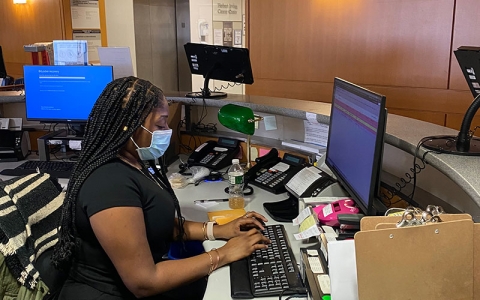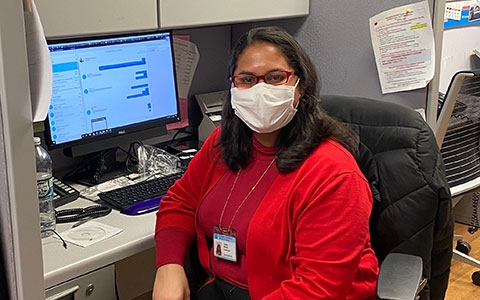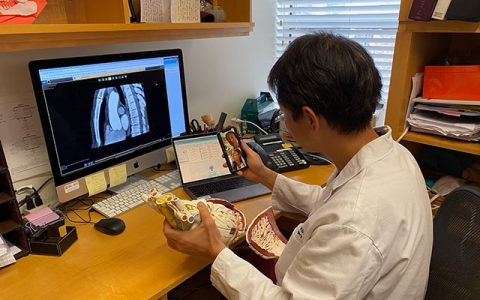Here For You, Now More Than Ever
COVID Quick Links
- Information about in-person visits
- Information on Virtual Visits
- Read the daily updates from Chief Surgeon Dr. Craig Smith that helped keep us together during the Covid-19 crisis
As a teaching hospital, we’re used to having answers. We pride ourselves on taking the most complicated cases, on being the best prepared. Well, no one could have been prepared for what we’ve all faced over the past few months.
We’ve learned a lot since the Covid-19 pandemic began. Lessons that helped us during the peak of hospitalizations in New York City, when nearly all of our resources were directed against a common foe, and lessons that continue to help us now, as we've resumed caring for the many patients whose needs didn’t stop just because the world turned upside down.
These are strange times. The idea of leaving home may seem scary, even if it’s to come for urgently-needed medical treatment. That’s why we want to share some of the lessons we’ve learned with you―so you can see how what we’ve been through has only strengthened our commitment to keeping you safe, healthy, and cared for.

Lesson: Safety First
When the Covid crisis first hit, there weren’t any safety protocols for us to follow. Nobody had been through this before, nobody knew what the “guidelines” were. So we created them. Through first-hand experience at the epicenter of the pandemic, we defined standards for keeping the spread of infection in check. Treating case after case of Covid, these brand-new protocols quickly evolved into deeply ingrained habits. Now, as we begin to open our doors back up to the rest of the world, we feel as prepared as possible to keep you safe and your mind at ease.
Here are some of the efforts we’re making to ensure your safety during this time:
- Pre-Appointment Screenings & Video Visits: Minimizing your risk of infection starts by determining whether an in-person visit is actually necessary for you. Our office administrators will work with you to determine if your needs can be met through a video or telephone appointment instead. Learn more about our video visits.
- Reduced Paperwork: Using the Columbia Connect app, you can submit all your forms digitally to our offices ahead of time, resulting in fewer papers to pass around and shorter waiting times. You can check-in 30 minutes before your appointment before coming into the lobby, and you can even pay your copay online. Connect with Columbia Connect.
- Extended Hours & Smaller Crowds: Our telehealth appointments help us reduce the overall number of visitors at our locations at any given time, so there will be far fewer people than usual at our locations to help reduce risk. We’ll also be extending our usual daily hours, so that appointments can be spaced out farther apart to keep traffic down.
- Facial Protection Available for All: For your safety and the safety of those around you, we have made the wearing of masks mandatory for everyone at all of our locations. Every patient and guest will be given a mask if they do not already have one.
- Temperature Check Points: Temperature check points with no-touch thermometers will help us screen for Covid symptoms and keep potential infections contained within designated sections of our facilities.
- Reconfigured Waiting Rooms: Look for the social distance decals on our chairs and floors to help you stay six feet from other patients and employees at all times. Social distancing will also be practiced in common areas like lobbies and elevators.
- Rigorous Sanitization Procedures: Our medical assistants completely wipe down the waiting room areas between each patient. Each exam room and its tools are sanitized between visits. Each of our frontline employees are required to put on a new pair of gloves between each patient interaction. Every element of our environment will be kept as clean as possible at all times.

We’re looking forward to a time when we don’t have to hide our faces behind masks when we see you, but until then, we’ll be ready and fully protected for you.
Lessons from the Frontline
“Every nurse, physician, environmental services worker, cafeteria worker, security guard are all dedicated to taking care of patients, families and each other. Not once did I hear a complaint of working long hours or working in gear that makes you feel like you are suffocating. EVERYONE worked together to make it happen.” ― Abby Oberec, Nurse Practitioner
Lesson: Trust in Transparency
The beginning of the Covid pandemic was marked by confusion. With so much unfolding so quickly, reliable information was hard to come by, even within our own institution. So our department chair, Craig Smith, MD, took action. In his own words:
We were shutting down ORs and research labs. The scarcity of PPE was frightening. Information was a salad of confusing rumors, rambling emails, and pronouncements from multiple sources. I attempted to write a simplifying summary. I wrote another, then another.
What began as a series of daily, internal memos to department faculty and staff soon became much more.
I sensed that people sharing such universal dislocation needed morale as much as information. I grew tired of using the phrases “fingers crossed” and “when the dust settles.” Near the beginning of Groundhog Day, the Bill Murray character says “Well, what if there is no tomorrow? There wasn’t one today.”
These were not your typical work memos. Dr. Smith’s updates acknowledged the fear and uncertainty of the moment directly, without reflexively countering with faint silver linings. It was the type of communication that lets people feel seen and heard, and it helped keep our department together when we needed it most.
Read: How a Department Chair Became America’s Covid Correspondent (from The Chronicle of Higher Education)
And that’s when we realized something. Something that seems so obvious in hindsight, but in the moment felt almost radical: what if we shared these internal updates with the public? We weren’t sure what people would think. Would the truth, uncertainty and all, create more panic in an already anxious society?
Read: The Pandemic’s Most Powerful Writer is a Surgeon (from the Wall Street Journal)
It turned out people value transparency more than posturing. The impact was immediate; emails and social media posts poured in, thanking Dr. Smith for the clarity―and for his humanity.
The proper way to communicate to employees in a time of crisis with transparent, realistic information and hope. Not with fear and subordination threats as most essential medical facilities seem to be using right now.
— Ryan Roehner (@ryerock16) March 26, 2020
Thank you for continuing your daily letters, Dr. Smith. They are harrowing to be sure, but also quite grounding. Be well.
— Lesley Meister, MD, FACOG (@docmeister) March 28, 2020
These daily updates from @ColumbiaSurgery are poignant, touching, perfect.
— Marc Cenedella (@cenedella) April 3, 2020
We learned something that perhaps we should have already known; we ask each of our patients to share their stories with us, to tell us about every up and down along their journey of illness. We value their sincere transparency more than anything―of course they would value ours as well.
See all of Dr. Smith's Updates here.
Lesson: From Adversity, Adaptability
Once the initial wave of Covid cases hit our emergency rooms, our “normal” ways of operating no longer mattered. Practices and routines that took years of training to master suddenly became meaningless. So we did what we had to do: we adapted.
Medical centers can be notoriously slow-moving organizations. The vow to “do no harm” usually means moving with an abundance of caution. But when losing time means losing lives, transformation can happen in a hurry.
Infection control meant cancelling elective procedures, which meant our operating rooms were sitting empty. So we turned them into intensive care units.
Our surgeons didn’t have their usual caseloads, so they took shifts in the EDs and ICUs.
Our residents formed a surgical SWAT team, helping over-taxed critical care doctors by making themselves on-call 24/7 to perform procedures.
New clinical trials were launched. New ventilator techniques were developed. New forms of PPE were engineered. And while all this innovation was going on, our doctors had to adapt to caring for their non-Covid patients from a distance, quickly establishing channels to deliver video visits on demand.

Some of our adaptations have served their time: the pop-up ICU beds are being transitioned back to operating rooms; the volunteers are returning to their usual jobs; the surgical SWAT team is winding down operations. Some changes are here to stay: video visits aren’t just a way to give you safer care right now, they mean more convenient care in general. But the biggest takeaway for us is the knowledge that we can truly change the system when we put our minds to it. We learned how to move faster and be more creative and flexible than ever before. Now, we’re stronger for it, ready to deliver better care than ever.
Lessons from the Frontline
“I was redeployed to the ICU during the first hotspot in the epidemic early on in the crisis. The integration of video technology was essential: we used video cameras to monitor multi-patients rooms to reduce exposure, and were able to use video apps to keep families in touch.” ― Dana Reed, Nurse Practitioner
Lesson: Courage Is At Our Core
The truth is, most healthcare workers don’t need to be brave. Smart, reliable, honest, hardworking, yes―but when it comes to taking risks, the real courage comes from our patients, those facing the full burden of illness, side-effects, and complications.
Maybe that’s why it was so heartening to learn that, when it was our turn to step up, we didn’t miss a beat. Physicians, nurses, technicians, administrators, staff all showed up to the frontlines to make sure we got through this. We never wavered in our devotion to our patients and to our city.

We didn’t do it because we’re fearless. Trust us, there was a lot of fear. We did it because we promised to be here for you. That was true during the darkest moments, and it continues to be true now.
As we approach something close to a “new normal,” resuming more and more of our usual activities, we recognize that uncertainty still lingers. We’ve learned a lot, but we still don’t have all the answers. No matter what, though, we will be brave. We will be your partner in care. And we cannot wait to work with you again.
Lessons From the Frontline
“Being a patient is hard, being a patient in isolation is nearly impossible, so when you think your compassion has run out, remember that and dig deeper.” ― Robert Brown Jr., MD, Transplant Hepatologist
Resources
- Read an interview with facilities operation director Francine Castillo to learn more about the changes we’ve made to help reduce the spread of Covid-19.
- Did you know you may not need to come into the office to meet one of our surgeons? Learn more about our video visit options for first meetings, second opinions or follow-up care.
- Read the daily updates from Chief Surgeon Dr. Craig Smith that helped keep us together during the Covid-19 crisis
- Learn more about how our residents formed a surgical SWAT team to tackle the coronavirus crisis
- Some forms to help you organize your next visit: Preparing | Taking Notes
- Find information and policies on the Coronavirus from Columbia University Irving Medical Center
- Coronavirus information from our partner hospital, NewYork Presbyterian, including the most up to date hospital visitor guidelines
